Laptop Mag Verdict
The OnePlus 10 Pro is a streamlined attack on the flagship phone market from OnePlus with a reduced price, competitive specs and a single model to avoid any confusion for buyers.
Pros
- +
Versatile triple camera array
- +
Aggressively priced
- +
Outstanding battery life and fast charging
- +
Bright 120Hz display
- +
Powerful Snapdragon 8 Gen 1 processor
Cons
- -
Limited to 128GB of storage
- -
Camera can't quite match top flagships
Why you can trust Laptop Mag
Price: $899
OS: OxygenOS 12.1 (Android 12)
Display: 6.7-inch ( 3216 x 1440 pixels) Fluid AMOLED LTPO with adaptive 120Hz
CPU: Qualcomm Snapdragon 8 Gen 1
RAM: 8GB
Rear cameras: 48MP wide (ƒ/1.8); 50MP ultra-wide (f/2.2); 8MP 3.3x telephoto (f/2.4)
Front camera: 32MP (f/2.2)
Storage: 128GB
Battery: 11:56 (120Hz); 12:28 (60Hz)
Size: 6.4 x 2.9 x 0.33 inches
Weight: 7.1 ounces
The OnePlus 10 Pro is a streamlined attack on the flagship phone market from OnePlus with a reduced price, competitive specs and a single model to avoid any confusion for buyers.
It gets the same new Snapdragon 8 Gen 1 processor as other Android flagships, a powerful triple camera array with telephoto, a vivid 120Hz adaptive display, a new design to stand out from the crowd and solid software support to assure the phone is up-to-date for years to come.
While OnePlus still comes up shy of Apple and Samsung’s best in a couple of regards, it outperforms them in several others and easily earns a spot among the best smartphones available today. Read on to find out if the OnePlus 10 Pro is the best choice for you.
OnePlus 10 Pro price and configurations
The OnePlus 10 Pro starts at $899, which includes 8GB of RAM and 128GB of internal storage. There are no upgrade options and no standard OnePlus 10 this year, so your only choice is whether you want the phone in Volcanic Black or Emerald Forest.
The $70 price drop from the OnePlus 9 Pro aligns with Google’s aggressive $899 price point for the Pixel 6 Pro and undercuts competitors like the iPhone 13 Pro and Samsung Galaxy S22+ by $100. This was the right move by OnePlus; although I’m sure some fans will be sorry to see the non-Pro model gone, the OnePlus 9 was a strong option that earned an editor’s choice from us last year.
I am disappointed that OnePlus isn’t offering the upgraded model with 12GB of RAM and 256GB of storage in North America, at least at launch. 128GB is the sweet spot for most people, but Google Photo storage or an alternative will be necessary to offload some of that content for heavy photo and video users.
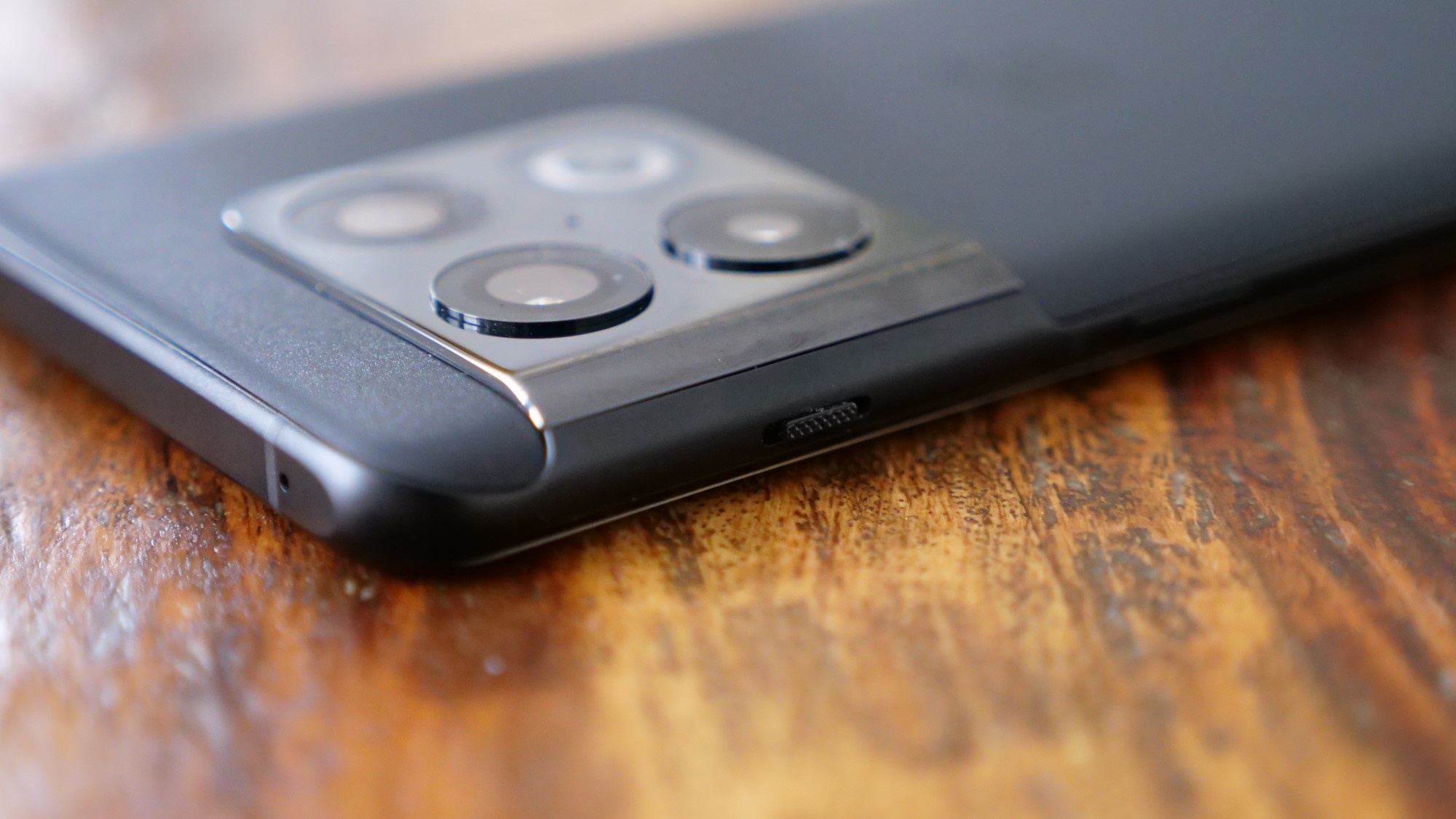
OnePlus 10 Pro design
The next generation of OnePlus’ “burdenless” design doesn’t break too significantly from last year. Still, it does tackle one of my primary complaints regarding the OnePlus 9 Pro. The new rear camera array certainly draws inspiration from Samsung’s Contour Cut Camera housing, but it puts enough of a spin on it to give the 10 Pro a distinct look to call its own. The ceramic-covered camera array wraps seamlessly from the aluminum frame to the rear glass panel with a gentle slope that almost lets you forget it's there.
Sign up to receive The Snapshot, a free special dispatch from Laptop Mag, in your inbox.
My review unit is the Volcanic Black model, which features a matte frosted glass finish that sheds fingerprints and almost delivers a soft-touch rubber feel that I miss from some old HTC phones. If you want a little more sparkle, the Emerald Forest model is a deep green that glints when the light catches it and still avoids getting smeared with fingerprints. Both are a dramatic improvement from last year, I found the OnePlus 9 Pro slippery, and CSI could have used it as a fingerprinting kit.
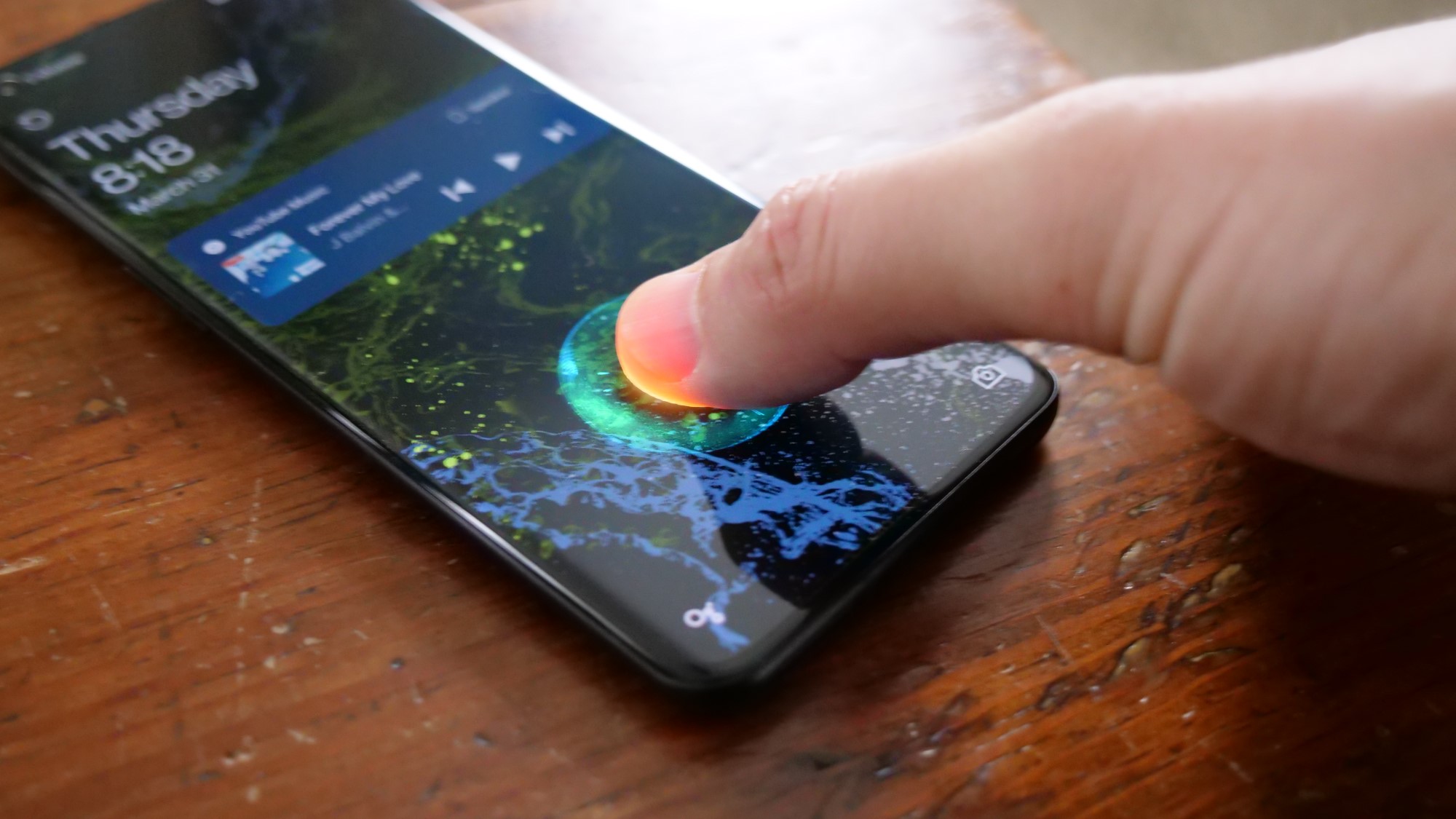
OnePlus still opts for a curved waterfall edge display on the 10 Pro, I understand it’s a premium look, but I’ve just never been a fan as I find the occasional accidental touches inevitable. It’s not a significant problem and it’s no worse than others that use it, but given the choice, I’d take a flat display. Otherwise, the ergonomics of the OnePlus 10 Pro are outstanding, with its slightly narrower frame making it more manageable one-handed than you would expect for a phone with a 6.7-inch display.
At 6.4 x 2.9 x 0.33 inches and 7.1 ounces, it is much more manageable than the Pixel 6 Pro (6.45 x 3 x 0.35 inches, 7.4 ounces) and is notably narrower than the Galaxy S22 (6.2 x 3 x 0.3 inches, 6.9 ounces), while the iPhone 13 Pro with its comparatively diminutive 6.1-inch display is naturally the smallest at 5.8 x 2.8 x 0.3 inches, but still actually outweighs the OnePlus at 7.2 ounces.
The OnePlus 10 Pro offers IP68 dust and water resistance certification, matching most of its flagship competitors. Durability may be a slight step down with a Gorilla Glass Victus covering on the display versus the Victus+ of the Galaxy S22+ or the Ceramic Shield of the iPhone 13 Pro, but it’s a marginal difference. On the back, you have Gorilla Glass 5 that should avoid scratches and withstand any minor bumps or drops. As drop tests prove time and again, every phone is vulnerable to a drop onto the concrete, so if you want to keep your phone pristine use a case.
A look at the ports and buttons reveals no changes from last year, with a volume rocker on the left side, a USB-C port at the bottom, a multi-function button and a ringer switch on the right.

OnePlus 10 Pro display
The OnePlus 10 Pro display is 6.7-inches with a QHD+ (3216 x 1440 pixels) resolution and a 120Hz Fluid AMOLED with an LTPO panel allowing for adaptive refresh rate changes based on the content on screen. The specs sound the same, but it’s a slight upgrade from last year with second-generation LTPO tech and Dual Color Calibration.
I turned to the “Octopus” episode of the documentary series Animals on Netflix to see how the OnePlus 10 Pro handled its typically gorgeous HDR footage. With the display in its Vibrant mode, it did not disappoint. This shot of a Nautilus moving through the inky blackness of the ocean shows the depth of color and contrast possible on the display along with the sharp detail of the intricate pattern in the plant it is emerging from.
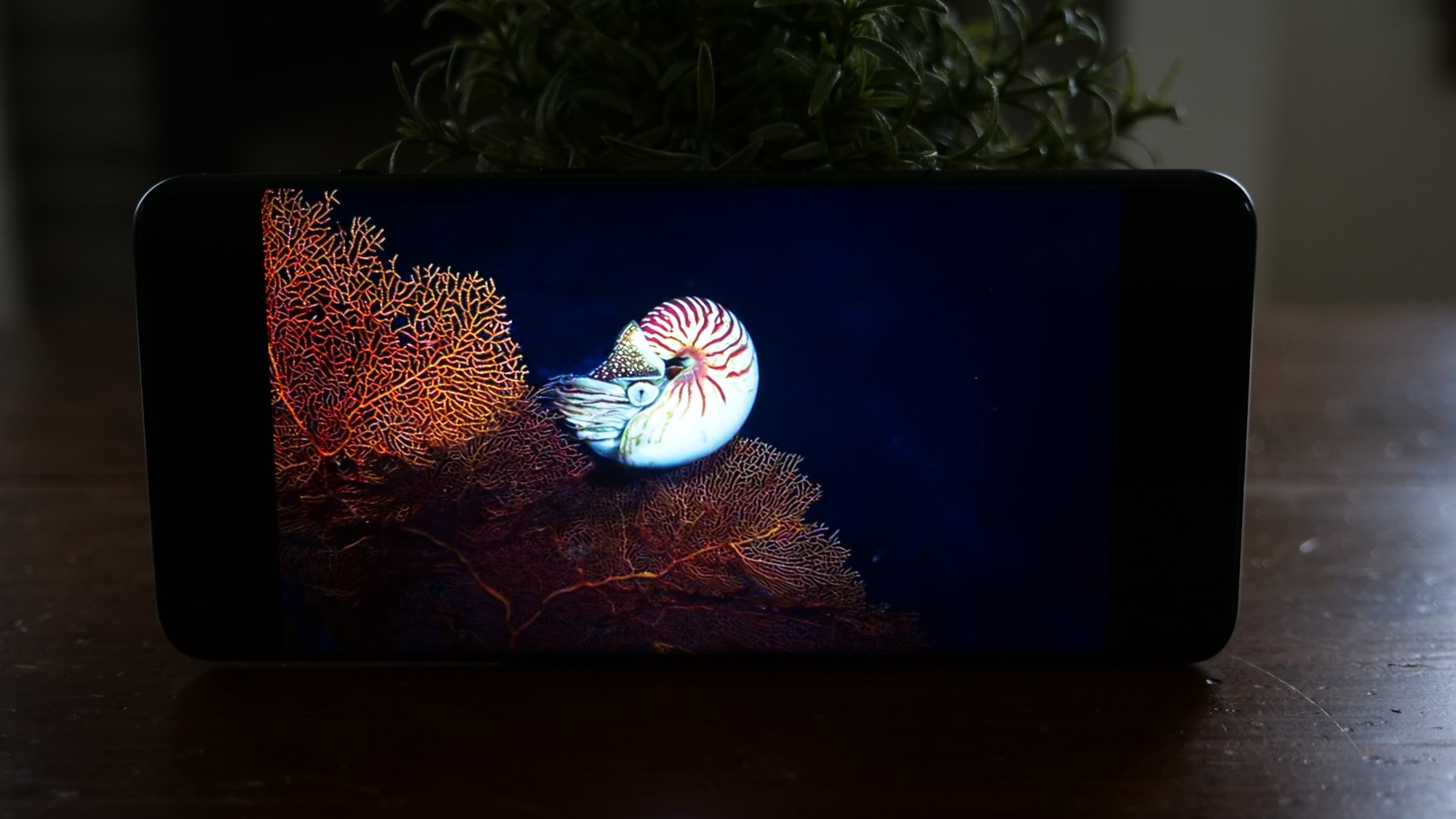
Our sensitive and expensive lab equipment offers a by-the-numbers look at the OnePlus 10 Pro's display performance. It reproduced 84.3% of the DCI-P3 color gamut in its Natural color setting. That’s enough to top the iPhone 13 Pro (82.5%) and the Pixel 6 Pro (73.8%), but the Samsung Galaxy S22+ (90.9%) is in no danger. While the iPhone 13 Pro has to tap out there, the Android phones boast a Vivid mode that lets the OnePlus 10 Pro jump to 123%, while the Galaxy S22+ remains the clear front runner at 150.2%.
Our Delta-E color accuracy test results (lower is better) went even better for the OnePlus 10 Pro at 0.23 in its Natural setting. That was good enough to tie the Galaxy S22+, while the iPhone 13 Pro and Pixel 6 Pro fell behind again at 0.27 and 0.30, respectively.
The OnePlus 10 Pro delivered a solid 738 nits of brightness at its max, which in any other year would have been outstanding; however, phones have blown the top off this category in the last few months. The Pixel 6 Pro (842 nits) was the closest to it, but the iPhone 13 Pro (1,024 nits) and Galaxy S22+ (1,326 nits) are on a different level entirely. These phones will hold up to use even in direct sunlight, but there’s no denying its competition outshines the OnePlus 10 Pro.
Overall the OnePlus 10 Pro display is outstanding, with HDR support and color enhancement that makes everything you view on it look fantastic. Samsung remains the undisputed champion of mobile displays, but OnePlus is easily among the strongest competition.
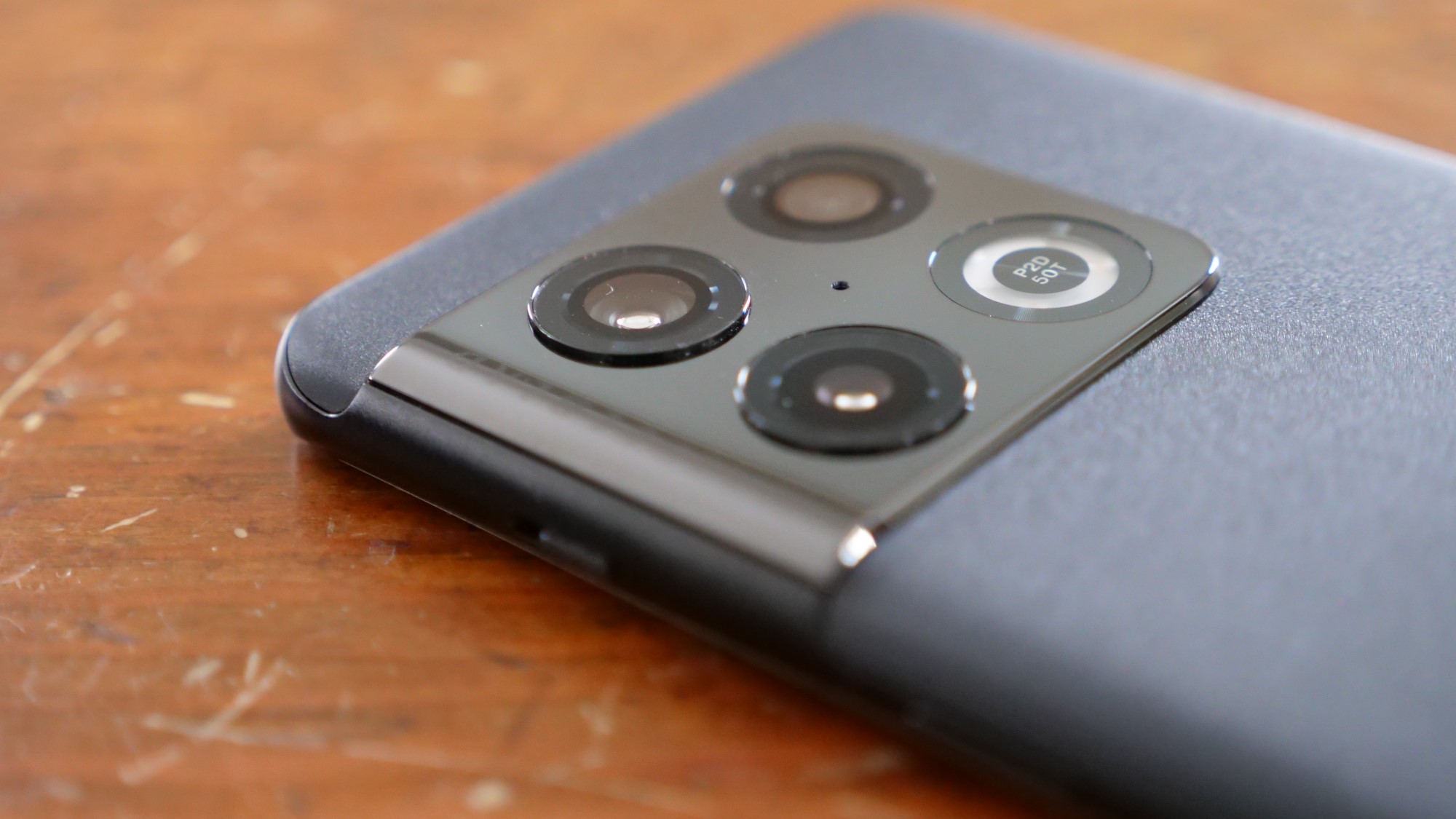
OnePlus 10 Pro cameras
While the look of the OnePlus 10 Pro camera changed dramatically this year, the changes to the hardware in that array were modest. The primary wide-angle camera remains the 48MP f/1.8 Sony IMX789 exclusive to OnePlus and the telephoto also remains the same, an 8MP at f/2.4. The ultra-wide is the only change on the back, moving to a 50MP f/2.2 Samsung ISOCELL JN1 with a dramatic 150-degree field of view. The front-facing camera is the only clear upgrade with a new 32MP Sony IMX615 sensor that’s double the megapixels and 27% wider than the OnePlus 9 Pro selfie camera.
The software remains the biggest story for now with the OnePlus partnership with Hasselblad. The improvement in the color science applied to its images is outstanding, and for those that want to dive deep into the camera settings, the Hasselblad Pro Mode unlocks some powerful tools. This includes up to 12-bit RAW capture, and if you use the new RAW+ mode, you can still retain the computational photography benefits of the 10 Pro while also getting all of the extra RAW image data to play with in post-processing. The new Master Style mode takes a page from Apple’s Photographic Styles with unique color calibration from a Hasselblad Ambassador and winners of a Hasselblad Masters contest.
Looking first at the primary camera, as you would expect, the output remains pretty close to what you saw with the OnePlus 9 Pro last year. While it’s not quite equal to the top-tier flagships from Apple and Samsung, it isn’t far off. I mainly find its limitations in low-light environments. Its colors in daylight are almost always spot on, hitting a happy medium between the at times dull images from the iPhone 13 Pro with the overly saturated Samsung look. In my oft-repeated shot of a nearby mural below, the OnePlus 9 Pro comes closer to the actual colors of the mural and the building itself than any of its competitors.

OnePlus 10 Pro wide-angle

OnePlus 10 Pro wide-angle low-light

OnePlus 10 Pro wide-angle Night mode

OnePlus 10 Pro wide-angle

OnePlus 10 Pro wide-angle
The ultra-wide change is the most interesting update this year, it’s a smaller sensor than last year’s but adds some intriguing creative possibilities. The 150-degree field of view is incredible if you want to get everything into a shot; the iPhone 13 Pro ultra-wide tops out at a 120-degree field of view as a point of comparison. OnePlus also did a flawless job of matching the color output from this sensor with the primary sensor. If you crop in on the ultra-wide shot, you wouldn’t know you hadn’t just used the primary. It’s a handy trick if you are trying to make sure you get everything in the shot and want to punch in later. Now as you can see in the shot of the silhouette prints, you will get some lens distortion if you go for the full 150-degrees, this is why it doesn’t default to that option, but it’s a fun effect and option to have. You can push it even further with the dedicated fisheye lens mode.

OnePlus 10 Pro ultra-wide

OnePlus 10 Pro ultra-wide night-mode

OnePlus 10 Pro ultra-wide low-light

OnePlus 10 Pro ultra-wide

OnePlus 10 Pro ultra-wide
The telephoto is the weak link in the chain for the OnePlus 10 Pro, and while it's disappointing, this is certainly the right priority. The 8MP telephoto delivers solidly sharp images with its 3.3x optical zoom, but the colors are just off, and it has more of a tendency to miss the exposure on a shot. In this shot of the same mural from earlier, the exposure and color are both off, with the red more drab than it should be.

OnePlus 10 Pro telephoto

OnePlus 10 Pro telephoto night mode

OnePlus 10 Pro telephoto low-light

OnePlus 10 Pro telephoto

OnePlus 10 Pro telephoto
The front-facing camera was the only sensor that got a notable upgrade, and it shows in the excellent output. While I would recommend shutting off the beauty modes as I can barely recognize myself when it gets too aggressive, those options are there if you like them. For standard selfies, it does a good job of capturing detail and while the edge detection in portrait mode isn’t perfect, it does well enough if you like that creamy bokeh background.
The OnePlus 10 Pro has strong video options with up to 8K at 24fps or 4K at up to 120fps from the primary sensor. Like the RAW photo mode, you also have a LOG format in Movie Mode that will allow you to apply your picture profile to the video to give you complete control of the final look. For vloggers or anyone just looking to mess around with video, there’s a Dual-View Video mode that lets you simultaneously record from the front and rear cameras to produce a side-by-side or picture-in-picture video.
OnePlus 10 Pro performance and graphics
The OnePlus 10 Pro features the same Snapdragon 8 Gen 1 processor you will find in most Android flagships this year, and it features 8GB of RAM. Just as we saw with the 9 Pro last year, OnePlus manages to squeeze a little extra performance out of Qualcomm’s offerings than most Android manufacturers, but naturally, the iPhone has nothing to fear.
The 10 Pro won’t find any challenges among common smartphone tasks. It breezed through my typical phone review gamut of a couple of dozen Google Chrome tabs, a Netflix video playing in the background, and then swapping between apps like Twitter, YouTube Music, and Gmail. While the A15 Bionic may be encroaching on laptop performance, Qualcomm’s best remains more than enough for even the most demanding mobile users.
All that extra power shines when gaming on the 10 Pro’s beautiful 120Hz display. OnePlus adds its HyperBoost Gaming Engine to Snapdragon’s range of tricks that improve performance with tools like GPA Frame Stabilizer and O-Sync for the most responsive gaming experience possible. While 120Hz support still needs to spread further, the adaptive 120Hz panel on the OnePlus 10 Pro means you are getting both the smoothest performance possible and the lowest refresh rate when that’s helping your battery life.

The Geekbench 5 score for the OnePlus 10 Pro is solid among the Snapdragon 8 Gen 1-powered Android flagships this year, with a multicore score of 3,482. The iPhone 13 Pro (4,718) may scoff at that, but the Pixel 6 Pro (2,760) wishes it could hit such heights and the Galaxy S22+ (3,361) falls short as well. The only head-scratcher here is that the OnePlus 9 Pro hit 3,685 last year with the Snapdragon 888; it’s unclear why Snapdragon 8 Gen 1 isn’t showing gains across the board.
Our Adobe Premiere Rush test has the phone convert a 4K video to 1080p; the OnePlus 10 Pro finished in one minute and two seconds. The iPhone 13 Pro (26 seconds) did its best Quicksilver impression on this one and could have gotten the rest out of the Adobe compound before they realized what happened, but the Galaxy S22+ (46 seconds) and Pixel 6 Pro (49 seconds) came a bit closer.
OnePlus staged a comeback in our Graphics testing; in the Wild Life Unlimited graphics test, the 10 Pro hit 61 frames per second, narrowly outperforming the Galaxy S22+ (60fps) and obliterating the Pixel 6 Pro (40fps). The iPhone 13 Pro (70fps) was the only thing standing between OnePlus and the gold.
The OnePlus 10 Pro did everything I asked of it, and I never felt like it was slow or lagging in use. While I’ll be watching to see if updates deliver any performance enhancements, the benchmarks shouldn’t be anything to steer you away from the 10 Pro.
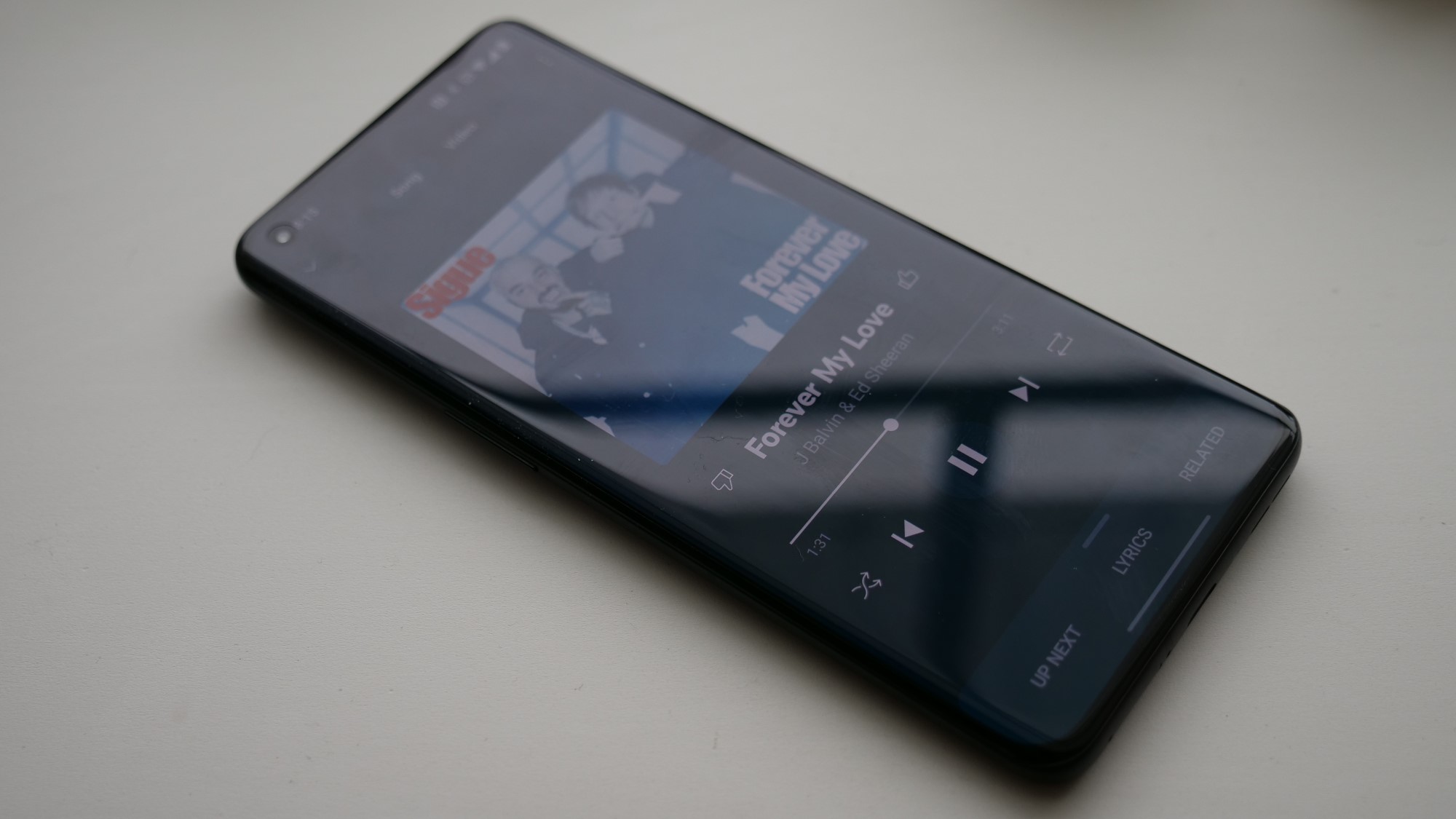
OnePlus 10 Pro audio
The OnePlus 10 Pro features dual stereo speakers and Dolby Atmos support. For calls I was perfectly happy with the speakers and the noise-canceling mics, I was able to easily hear and be heard with the phone docked in my car.
For music, I was less enamored with it. I listed to J Balvin & Ed Sheeran’s “Forever my love” and up to about 50% volume everything was great, the echoing harmonies and gentle strumming of the guitars were pleasant and relaxing. Then I decided to turn things up and try to fill my 18 x 12-foot listening space and that’s where it went off the rails, it added a vibration that distorted the audio completely. I didn’t have the same issue with watching shows or movies at high volume, so it’s not a big deal to me as I’d typically turn to my wireless earbuds for music anyway, but it’s worth noting if you do like your phone to do double duty as a speaker.
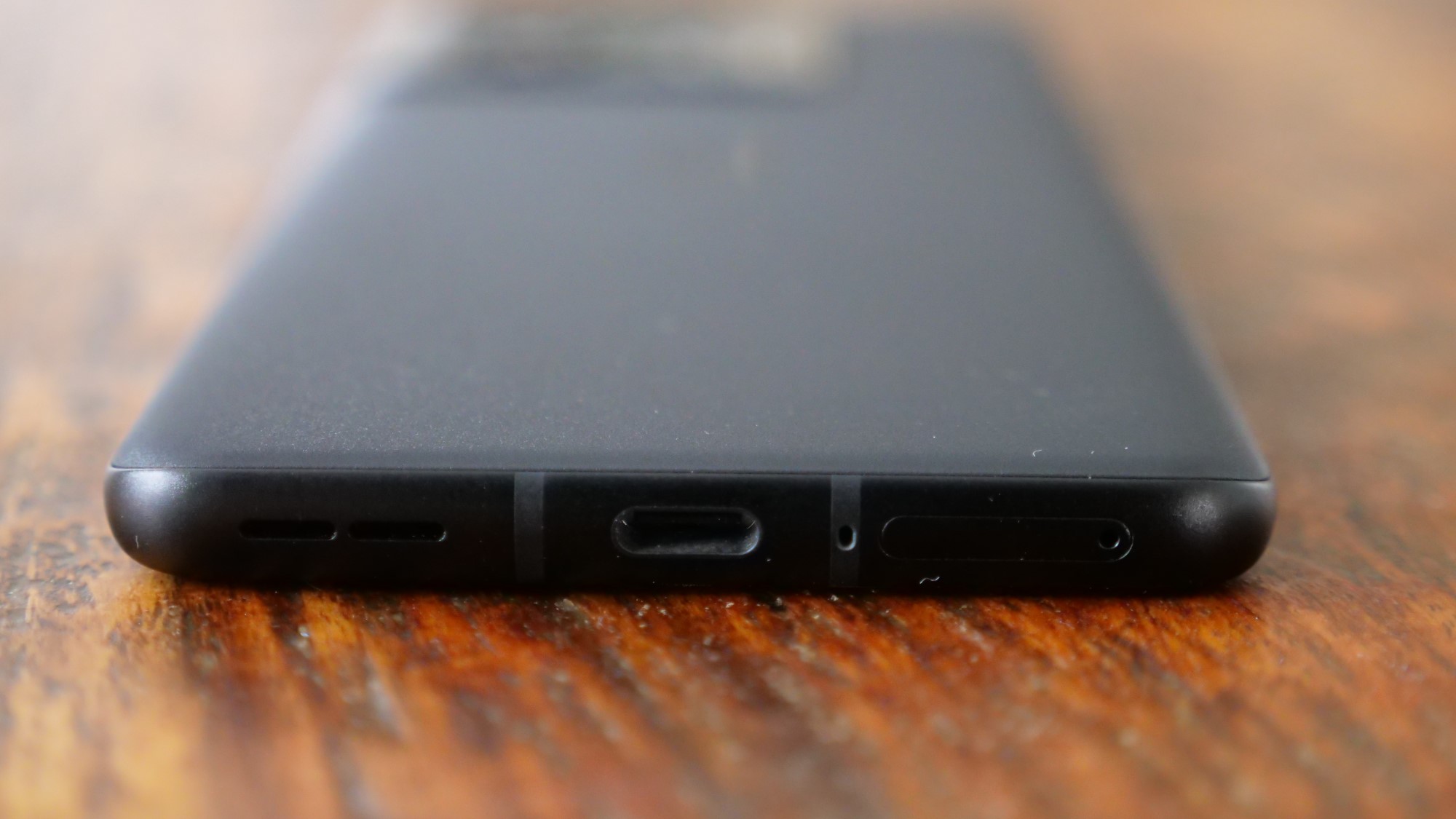
OnePlus 10 Pro battery life and charging
OnePlus differentiated itself against the flagship competition with its fast-charging last year. With little movement from the competition there, it continues to do so. However, this year it adds impressive battery life to its accolades. OnePlus bumped the dual-cell battery of the 10 Pro up to 5,000mAh this year, and marathon phone users should take notice.
Our Laptop Mag Battery test has the phone continuously surf the web over cellular with the display set to 150 nits of brightness; the OnePlus 10 Pro, on its adaptive refresh rate setting, averaged 11 hours and 56 minutes. Dropping the display to its 60Hz setting bumped this up to 12 hours and 28 minutes. That’s just four minutes shy of the long-lasting iPhone 13 Pro (12:00) and hours beyond the Galaxy S22+ (9:27) and Pixel 6 Pro (7:47).
During my reviews, I typically take the phone off the charger at 7:30 a.m. and return it to the charger at around 10:30 p.m. after roughly 2 hours of Netflix and/or YouTube streaming on Wi-Fi, web browsing, using social media, gaming for about 30 minutes and capturing photos and videos. With that basic mixed usage, the OnePlus 10 Pro was never close to falling asleep before I did, with typically roughly 20-25% remaining at the end of the day.
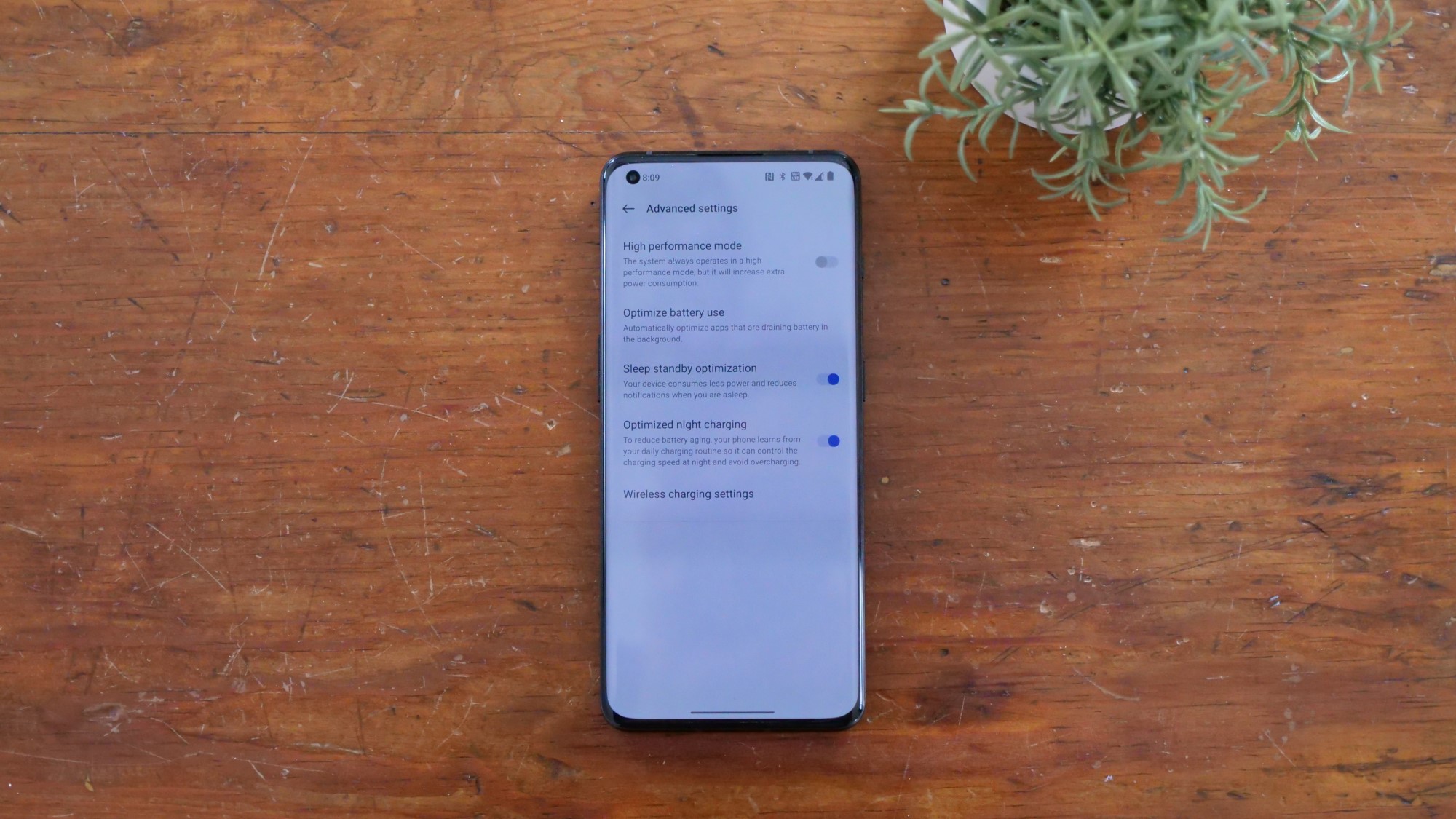
The OnePlus 10 Pro will immediately find its way onto our phones with the best battery life. Only the Asus ROG Phone 5 at its 60Hz setting offers better battery life among non-Apple and Samsung flagships.
While OnePlus fans were hoping for the 80W charging that the company delivered in the 10 Pro in China, we are limited to the still excellent 65W charging here, and yes, the charger is still included in the box. This allows you to get a 93% charge in 30 minutes or 55% in 15 minutes. Only the Galaxy S22+ with its new 45W charger (that you must buy separately) comes close at 70% in 30 minutes and 37% in 15 minutes.
If you are prone to running your phone hard, this category should weigh heavily for you, and OnePlus is still dominant in charging and hot on Apple’s heels for the best battery life.
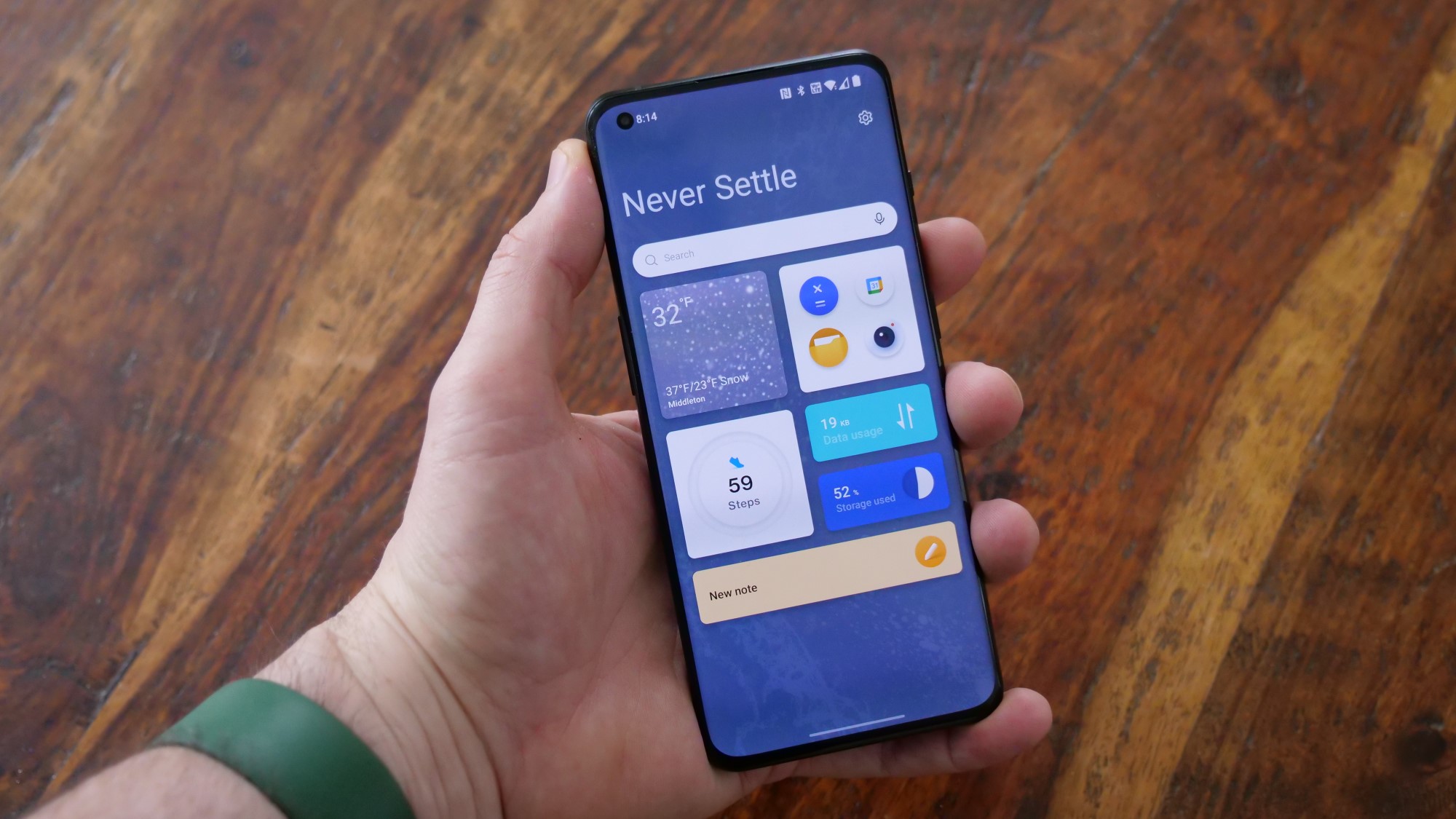
OnePlus 10 Pro software
The OnePlus 10 Pro runs OxygenOS 12.1, a modified version of Android 12. I’ll address some of the specific touches OnePlus adds in a moment, but when it comes to software support, OnePlus is committed to three major OS updates and four years of security updates. This falls slightly behind Samsung (4 major OS updates/4 years of security updates) and Google (3 major OS updates/5 years of security updates), but it’s good enough not to be a concern for most users who likely upgrade within 3-4 years. Apple remains the gold standard with roughly 6 years of OS and security updates.
OxygenOS 12.1 looks more like Samsung’s One UI than the Pixel version of Android and it adds a few unique features to the mix. This includes the OnePlus Shelf, an easily glanceable collection of widgets for access to some of your most-used tools with a swipe down from the top-right corner of the screen. This is also where you find OnePlus Scout, which will do a full search of any content on your phone.
Work Life Balance 2.0 from OnePlus is akin to Focus modes on macOS and iOS, allowing you to reduce distractions from either your work or home life depending on whether you are or what time it is. Finally, for those with privacy concerns, a new Private Safe can store videos, photos, documents, or any digital data you want behind a password or fingerprint encryption that is inaccessible by any other apps.

Bottom line
The OnePlus 10 Pro at $899 is an outstanding value that for the right buyer is the best phone available today. It offers performance on par with anything on the Android side, battery life that rivals even the iPhone, a gorgeous display that is only outdone by Samsung and fast charging that still blows away any of the competition in the U.S.
Its weaker low-light performance and telephoto zoom lens compared to the iPhone 13 Pro, Galaxy S22+ or Pixel 6 Pro are the biggest complaints that can be laid at the 10 Pro’s feet. These features can’t be dismissed, but they certainly aren’t important to all users.
If you use your phone for the occasional snapshot but are primarily concerned with performance, display and battery life, it would be hard for me to recommend anything other than the OnePlus 10 Pro to you. Depending on what Google has in store later this year, the 10 Pro could be the best flagship Android value in 2022.
Sean Riley has been covering tech professionally for over a decade now. Most of that time was as a freelancer covering varied topics including phones, wearables, tablets, smart home devices, laptops, AR, VR, mobile payments, fintech, and more. Sean is the resident mobile expert at Laptop Mag, specializing in phones and wearables, you'll find plenty of news, reviews, how-to, and opinion pieces on these subjects from him here. But Laptop Mag has also proven a perfect fit for that broad range of interests with reviews and news on the latest laptops, VR games, and computer accessories along with coverage on everything from NFTs to cybersecurity and more.


